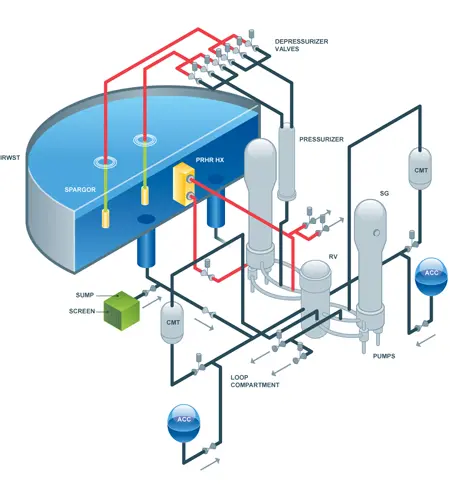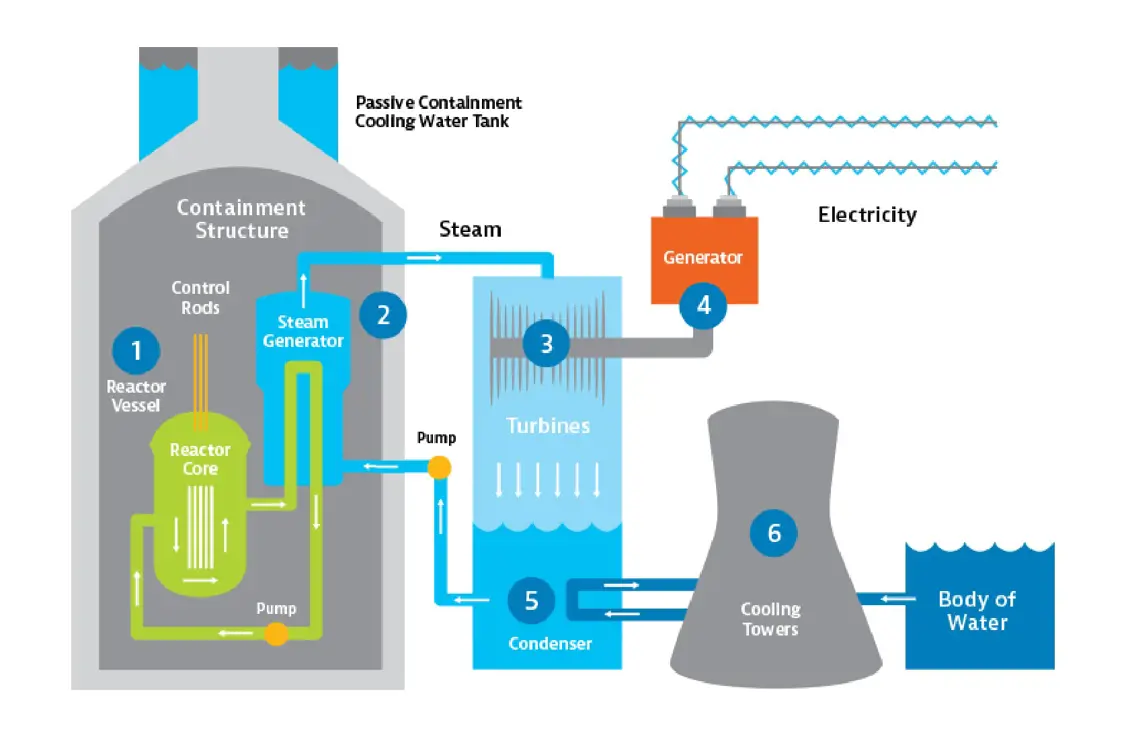Plant load management performance includes faster response time, less waste, a large margin between operating range and safety system actuation, and passive accommodation for load swings.
An important aspect of the AP1000® PWR design philosophy focuses on reactor operability and maintainability. The passive safety features use a much smaller number of valves than do the multiple trains of active pump-driven systems, and there are no safety pumps at all; so, there is less in-service testing to perform. In particular, simplified safety systems reduce surveillance requirements, significantly simplifying technical specifications and reducing the likelihood of forced shutdowns. Lower operating and maintenance requirements lead to smaller maintenance staffs.
The variable-speed canned-motor reactor coolant pumps (RCPs) simplify reactor startup and shutdown operations because they are capable, for example, of reducing RCP speed during reactor cooldown and providing the capability to vary RCP speed to better control shutdown operating-mode transitions. The RCPs operate at constant speed during power operations, simplifying control actions during load shifts.
The digital I&C design significantly reduces required I&C surveillance testing and simplifies trouble-shooting, repair and post-maintenance testing. The reactor includes automation of some cooldown operations and improved steam-dump, low-pressure performance. The advanced control room design significantly improves the operator interfaces and reactor operations capabilities.
Overall, the selection of proven components has been emphasized to ensure a high degree of reliability and reduced maintenance requirements. Component standardization reduces spare-parts inventories, maintenance, training requirements, and allows shorter maintenance times. Built-in testing capability is provided for critical components.
Reactor layout ensures adequate access for inspection and maintenance. Laydown space provides for staging of equipment and personnel, equipment removal paths, and space to accommodate remotely operated service equipment and mobile units. Access platforms and lifting devices are provided at key locations, as are service provisions such as electrical power, demineralized water, breathing and service air, ventilation and lighting, and computer-data-highway connections.

The AP1000 reactor also incorporates radiation exposure reduction principles to keep worker dose as low as reasonably achievable (ALARA). Exposure length, distance, shielding, and source reduction are fundamental criteria that are incorporated into the design with the result of:
The AP1000 reactor is designated for rated performance with up to 10 percent of the steam-generator tubes plugged and with a maximum hot-leg temperature of 321.1°C (610°F). The reactor is designed to accept a step-load increase or decrease of 10 percent between 25 and 100 percent power without reactor trip or steam-dump system actuation, provided that the rated power level is not exceeded. Further, the AP1000 reactor is designed to accept a 100 percent load rejection from full power to house loads without a reactor trip or operation of the pressurizer or steam generator safety valves.
The AP1000 reactor’s outstanding early performance has an 85.6% average Operation Availability Factor. This includes the SM2 unit with the early RCP issue. The remaining 3 AP1000 units' Operation Availability Factor is 93% - the industry's best.
With four units setting records in full commercial operation, the AP1000 reactor represents the most advanced technology available today, able to supply over 1 GW of electricity to centralized power grids.
Operating nuclear plants in the U.S. are already competitive producers of electricity compared to coal-fired plants. That virtue is enhanced by fuel cost comprising only about 25 percent of the production costs of a nuclear plant. The remaining 75 percent of production cost is the fixed cost of operation and maintenance.
That means that nuclear power production is less sensitive to changes in fuel costs than coal-fired plants where fuel costs can be more than 75 percent of the production cost. The AP1000 reactor’s modern design will engender even less expensive production by requiring less manpower for O&M than current plants for many reasons, including:
An independent study by the Institute of Nuclear Power Operations (INPO) determined that a passive “single, mature Advanced Light Water Reactor” would require about one-third less O&M staff than a currently operating nuclear plant.
